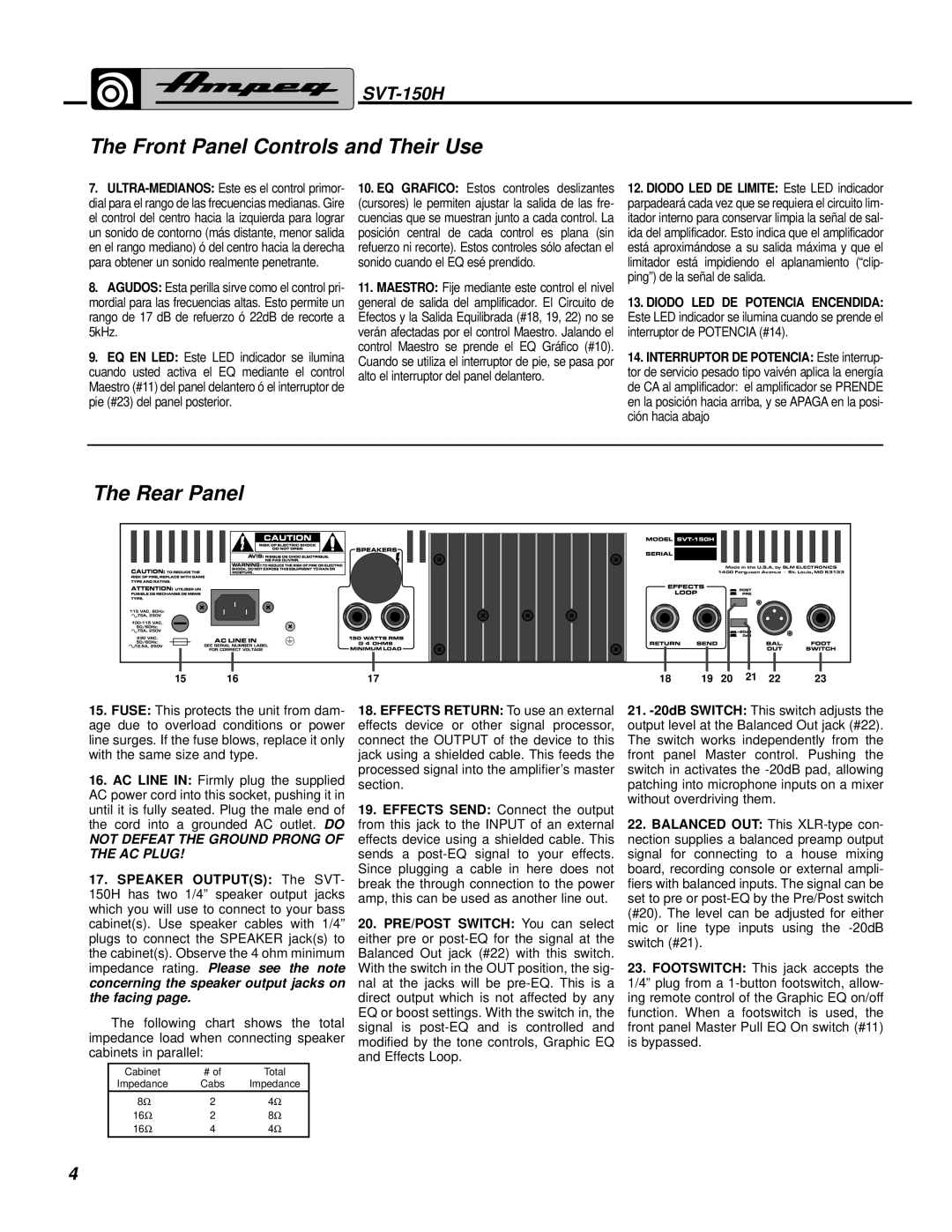
SVT-150H
The Front Panel Controls and Their Use
7.
8.AGUDOS: Esta perilla sirve como el control pri- mordial para las frecuencias altas. Esto permite un rango de 17 dB de refuerzo ó 22dB de recorte a 5kHz.
9.EQ EN LED: Este LED indicador se ilumina cuando usted activa el EQ mediante el control Maestro (#11) del panel delantero ó el interruptor de pie (#23) del panel posterior.
10.EQ GRAFICO: Estos controles deslizantes (cursores) le permiten ajustar la salida de las fre- cuencias que se muestran junto a cada control. La posición central de cada control es plana (sin refuerzo ni recorte). Estos controles sólo afectan el sonido cuando el EQ esé prendido.
11.MAESTRO: Fije mediante este control el nivel general de salida del amplificador. El Circuito de Efectos y la Salida Equilibrada (#18, 19, 22) no se verán afectadas por el control Maestro. Jalando el control Maestro se prende el EQ Gráfico (#10). Cuando se utiliza el interruptor de pie, se pasa por alto el interruptor del panel delantero.
12.DIODO LED DE LIMITE: Este LED indicador parpadeará cada vez que se requiera el circuito lim- itador interno para conservar limpia la señal de sal- ida del amplificador. Esto indica que el amplificador está aproximándose a su salida máxima y que el limitador está impidiendo el aplanamiento (“clip- ping”) de la señal de salida.
13.DIODO LED DE POTENCIA ENCENDIDA: Este LED indicador se ilumina cuando se prende el interruptor de POTENCIA (#14).
14.INTERRUPTOR DE POTENCIA: Este interrup- tor de servicio pesado tipo vaivén aplica la energía de CA al amplificador: el amplificador se PRENDE en la posición hacia arriba, y se APAGA en la posi- ción hacia abajo
The Rear Panel
|
|
|
|
| Made in the U.S.A. by SLM ELECTRONICS | |||
|
|
|
|
| 1400 Ferguson Avenue • St. Louis, MO 63133 | |||
15 | 16 | 17 | 18 | 19 | 20 | 21 | 22 | 23 |
15.FUSE: This protects the unit from dam- age due to overload conditions or power line surges. If the fuse blows, replace it only with the same size and type.
16.AC LINE IN: Firmly plug the supplied AC power cord into this socket, pushing it in until it is fully seated. Plug the male end of the cord into a grounded AC outlet. DO
NOT DEFEAT THE GROUND PRONG OF THE AC PLUG!
17.SPEAKER OUTPUT(S): The SVT- 150H has two 1/4” speaker output jacks which you will use to connect to your bass cabinet(s). Use speaker cables with 1/4” plugs to connect the SPEAKER jack(s) to the cabinet(s). Observe the 4 ohm minimum impedance rating. Please see the note concerning the speaker output jacks on the facing page.
The following chart shows the total impedance load when connecting speaker cabinets in parallel:
Cabinet | # of | Total |
Impedance | Cabs | Impedance |
8Ω | 2 | 4Ω |
16Ω | 2 | 8Ω |
16Ω | 4 | 4Ω |
18.EFFECTS RETURN: To use an external effects device or other signal processor, connect the OUTPUT of the device to this jack using a shielded cable. This feeds the processed signal into the amplifier’s master section.
19.EFFECTS SEND: Connect the output from this jack to the INPUT of an external effects device using a shielded cable. This sends a
20.PRE/POST SWITCH: You can select either pre or
21.
22.BALANCED OUT: This
23.FOOTSWITCH: This jack accepts the 1/4” plug from a
4
